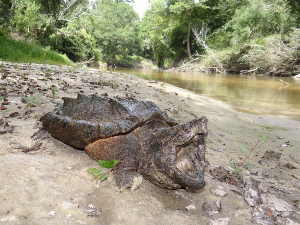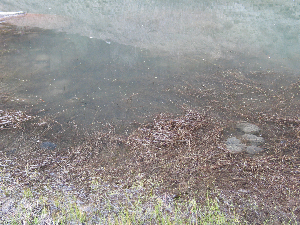Search ARMI Database
Search term(s)
Contribution Number
Search Results
9 record(s) found.
Data Release Amphibian (chorus frog, wood frog, tiger salamander) surveys in Rocky Mountain National Park (1986-2022)
Authors: Amanda M Kissel; Erin Muths
Date: 2023-01-24 | Outlet: sciencebase
This data release contains information collected during surveys for chorus fogs (Pseudacris maculata), wood frogs (Lithobates sylvaticus) and tiger salamanders (Ambystoma mavortium) conducted in Rocky Mountain National Park (1986 – 2022) by the U.S. Geological Survey. Survey methods included visual encounter and aural surveys, and dip netting. Data collected between 1986 and 1994 focused on named water bodies in Rocky Mountain National Park. Data collected between 1995 and 1999 are from focal monitoring sites as well as sporadic surveys of other wetlands. Data collected between 2000-2002 represent repeated surveys conducted between 1986 and 1994 (e.g., park-wide surveys of named water bodies) and additional surveys of unnamed waterbodies. Data collected after 2002 were collected under an occupancy framework. Sites were identified within pre-defined catchments using the National Wetlands Inventory Database to locate potential amphibian breeding habitat (e.g., ponds, ephemeral wetlands). If appropriate sites were encountered in the field and were not indicated on National Wetland Inventory databases (https://www.fws.gov/program/national-wetlands-inventory/metadata), they were added as incidental sites. Waterbodies were visited and surveyed at least two times during the amphibian active season (May and mid-August). Water bodies were surveyed for all life stages of amphibians.
Data Release Data from a road ecology study of Spotted Salamanders along the Natchez Trace Parkway, Mississippi, in 2012-2013
Authors: Brad M Glorioso; Hardin J Waddle
Date: 2025-03-25 | Outlet: ScienceBase
This dataset contains study results examining the effect of road mortality on migrating salamanders along the Natchez Trace Parkway in Mississippi from 2012-2013. A combination of methods were used to assess the movement of salamanders to and from the breeding pond. Environmental variables such as air and water temperature, water salinity, and relative humidity were also collected during the study. A traffic counting device was also installed at the edge of the study area to monitor the number of vehicles passing through the area during migration events. Surveys to quantify egg masses in the breeding pond were also completed during the study.
Data Release Data from a turtle trapping effort at a release site of head-started alligator snapping turtles, Macrochelys temminckii, in southwest Louisiana in 2018
Authors: Brad M Glorioso; Charles D Battaglia; J Streeter; Hardin J Waddle
Date: 2020-05-01
This dataset contains initial data from head-started alligator snapping turtles released by Louisiana Department of Wildlife and Fisheries (LDWF) from November 2015 to October 2016. In addition, it contains data from a five-day trapping effort at each of seven release sites by the United States Geological Survey (USGS) from late June to early October 2018. Trapping was completed using hoop nets of three sizes. We recaptured eight head-started alligator snapping turtles as well as four individuals native to the creek.
Data Release Chloride in water, metals in sediment and amphibian tissues and amphibian capture information from wetlands in the Williston Basin of Montana and North Dakota, 2015-2017: U.S. Geological Survey data release
Authors: Kelly L Smalling; Blake R Hossack; R K Honeycutt; Chauncey W Anderson; I M Cozzarelli,
Date: 2018
Data release for data collected from Prairie Pothole wetlands.
Data Release Amphibian acoustic data from the Arizona 1, Pinenut, and Canyon breccia pipe uranium mines in Arizona: U.S. Geological Survey data release
Authors: J E Hink,; Blake R Hossack; R K Honeycutt
Date: 2017
Data release for acoustic monitoring of amphibians at 3 mine sites.
Data Release Annotated bibliography of grazing effects on amphibians and their habitats (ver. 2.0, February 2022)
Authors: Jennifer C Rowe; Christopher A Pearl; Michael J Adams; Brome McCreary
Date: 2022-02-10 | Outlet: Science Base
Livestock grazing is one of the most common land uses in the western United States, where multiple amphibians of conservation concern use habitats that are grazed. Despite the common intersection of grazing and sensitive amphibian species, there are very few reviews of research related to the issue. USGS researchers compiled and summarized literature pertaining to livestock grazing effects on amphibians and their habitats, with an emphasis on wetland-breeding species in the western United States. Users of the annotated bibliography can utilize an integrated search tool with user-defined criteria to query records and output results. This tool aids users in synthesizing research related to a range of specific questions and should assist land managers in evaluating and implementing grazing while maintaining habitat for wetland amphibians.
Data Release Oregon spotted frog (Rana pretiosa) telemetry and habitat use at Klamath Marsh National Wildlife Refuge in Oregon, USA
Authors: Christopher A Pearl; Jennifer C Rowe; Brome McCreary; Michael J Adams
Date: 2019-12-13 | Outlet: Science Base
We used radio-telemetry to study late-season movement and habitat use by Oregon spotted frogs (Rana pretiosa) at Klamath Marsh National Wildlife Refuge in Oregon. This data release includes frog location and habitat use data, as well as visualizations of telemetry data. Tracking events occurred roughly weekly between August and December of 2017.
Data Release Nutrients, estrogenicity, and fecal indicators in surface water collected from wetlands in the Klamath Marsh National Wildlife Refuge, Oregon, 2017-2018
Authors: Jennifer C Rowe; Kelly L Smalling; Christopher A Pearl; C E Givens; A J Sperry; Michael J Adams
Date: 2019-12-13 | Outlet: Science Base
The data was gathered to determine the effects of cattle grazing on wetland water quality in the Klamath National Wildlife Refuge in Oregon. Surface water samples from sites representing a range of grazing histories were collected between June and October in 2017 and 2018. Samples were analyzed for nutrients (ammonia, nitrate plus nitrite, nitrite and orthophosphate), total coliforms, E. coli, enterococci and estrogenicity by US Geological Survey laboratories. Basic water quality parameters such as temperature, pH, turbidity and specific conductance were also collected in the field during each site visit. Quality assurance samples (blanks and replicates) as well as method information is also included in the data release.
Data Release Columbia Spotted Frog (Rana luteiventris) Breeding at Grazing Exclosures in Eastern Oregon 2002-2010 and 2013: U.S. Geological Survey data release
Authors: Michael J Adams; Christopher A Pearl; Brome McCreary; Stephanie K Galvan; Jennifer C Rowe
Date: 2018-02-01 | Outlet: ScienceBase
We studied the short-term effects of full and partial livestock grazing exclosures on Columbia Spotted Frog (CSF; Rana luteiventris) populations using a controlled manipulative field experiment with pre- and post-treatment data. This dataset includes vegetation data collected 2002-2010 and 2013 at 94 lakes and ponds in and around the Blue Mountains in eastern Oregon. Data collection followed standardized survey protocols and included annual oviposition surveys and vegetation surveys. These data allowed for quantification of CSF breeding as related to vegetation within and outside of grazing exclosures at each site.



